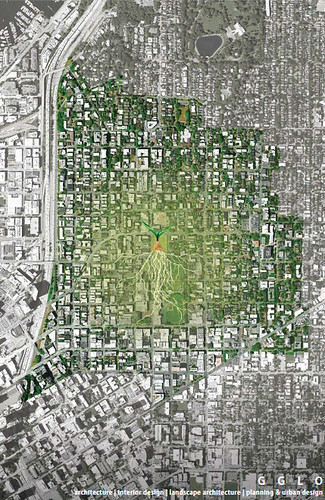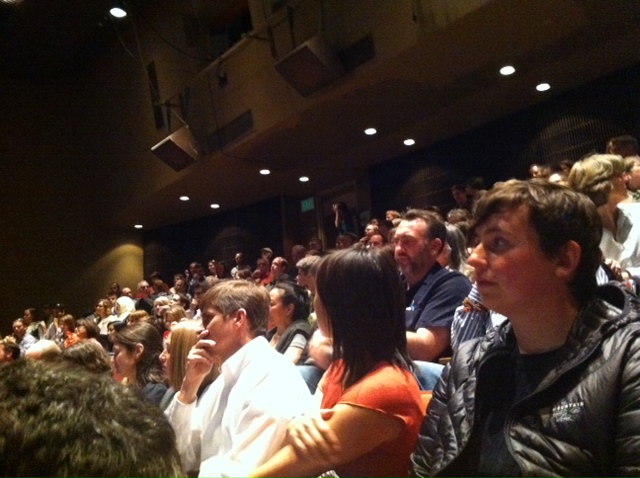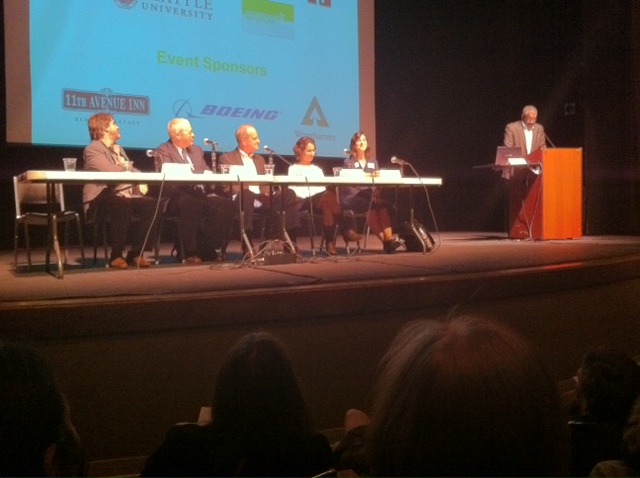
Broadway Performance Hall was packed full of the greenest folk on Capitol Hill Tuesday night to discuss the neighborhood’s future as an EcoDistrict. Capitol Hill Housing’s 7th Annual Community Forum brought together a panel that included Mayor Mike McGinn, president of the Bullitt Foundation — and founder of Earth Day — Denis Hayes, and King County Executive Ron Sims, who moderated the event.
An “EcoDistrict” refers to a neighborhood committed to sustainability through reinvigorated infrastructure and a focus on various environmental areas like energy, water and transportation. The result could be a zone around Capitol Hill’s light rail station created with incentives for developers to build green, sustainable buildings — similar in ways to the Pike/Pine Conservation District’s incentives for encouraging preservation. What that would actually mean, how it work, and, to some extent, how it would be paid for, were all on the table Tuesday night.
Alex Brennan of Capitol Hill Housing and Alicia Daniels Uhlig of GGLO presented an abbreviated version of an extensive analytical report on the project, which is being funded by the Bullitt Foundation as it constructs its new headquarters at 15th and Madison.
The findings are comprised of a thorough set of metrics and data to support the project, as well as a list of possible goals and benchmarks to shoot for. A brief version of the presentation can be found here. The reports call for carbon-neutrality in the city by 2050, as well as reduced water usage and increased canopy coverage. A simulated image of Dick’s on Broadway within the projected EcoDistrict shown at the conference made the fast food joint look like a majestic oasis in the middle of a beautiful urban rainforest.
As panel member Llewellyn Wells, President of Living City Block said, “It’s all pie in the sky unless people in this room and this community take up the work.” The “work” that needs to be done ranged across a variety of issues:
-
 The packed audience was repeatedly begged to fill out participation cards.
The packed audience was repeatedly begged to fill out participation cards.“One of the challenges of building a sustainable building is that it’s mostly illegal in Seattle,” Hayes said. The comment drew laughs as Hayes explained how difficult city codes made it to construct the nearly finished Bullitt Center on 15th Ave and E Madison, what is being billed as “The greenest building in the world,” and the world’s first completed Living Building. Hayes broke down the policy shifts needed from the city as well as bank investors and called for a shift in the standards of appraisal used to value buildings. Hayes called for exemptions to restrictive codes and policies to be set in place for special green projects like the Bullitt Center.

- McGinn echoed Hayes’ concerns. “Making sustainability legal is hard,” he said, calling for more of a prescriptive approach to policy making rather than a simple outcome based method that emphasizes quick fiscal turnaround. In addition, McGinn suggested that “Seattle could revitalize its industry sectors by becoming a leader for sustainable manufacturing,” to a round of applause from the audience.
- Panel member Naomi Cole brought her experience from directing the EcoDistrict program in Portland, advising Seattleites to come up with a definitive coordinated strategy that is led by the city, as well the importance of choosing an appointed community leader to spearhead the project.
- Rebecca Saldaña, Program director of Equitable Transit Oriented Development at Puget Sound Page made it clear that EcoDistricts should reflect the needs and wants of the communities their built in. “What we want and need in Capitol Hill might not be what is wanted or needed in Rainier Beach,” Saldaña said. “But if we communicate across neighborhoods, you’ll see that we have a lot of things in common.”
- Wells emphasized the value of retrofitting existing buildings. “When it comes down to it, the most sustainable thing we can do is work with what’s already there.”
- During audience Q&A, issues were brought up around engaging youth in the EcoDistrict project, as well as how to engage low-income communities and communities of color.
Cole challenged the assumption that those communities wouldn’t be engaged by the program. “Out of the five pilot neighborhoods where we started these EcoDistrict projects, by far the two most enthusiastic neighborhoods were the most culturally diverse, low-income neighborhoods. Many of these neighborhoods are used to dealing with issues on a reactive level, so when the opportunity comes to work together on a common goal on a more proactive level, the result is energizing.”
For more on this week’s forum, check out this post from CHS contributor John Feit of Schemata Workshop:
The Report and CHH’s roll-out are well timed, coming as they (supposedly) came out less than six month’s from the date that Sound Transit says they will release the Request for Proposals (RFP) for the Capitol Hill station’s TOD development sites. The sites, which figure prominently and are in fact the literal center of the Report’s maps, present the best early opportunity for furthering the Report’s goals as they will be the largest single assembly of adjacent private development parcels likely to hit the market for the foreseeable future, and are in fact large enough to realize many of the economies of scale required for implementing the Report’s strategies. How the Eco-District Report figures into the development TOD parcels are yet to be seen, but there is no doubt that the vision of the Report and the best interests of the community will be served by developers who are responding to the RFP that have both a proposal and track record that testifies to an ability to make the TOD Capitol Hill’s first significant contribution to our Eco-district goals.
Here is the full Capitol Hill EcoDistrict report:




Great idea. I love all of the talk around this, however what this city needs is more action. I have lived on Cap Hill for the past 2 1/2 yrs, and in that time, instead of saving any old building and/or figuring out a way to incorporate an old building into the end result, the buildings are torn down. Case in point, last summer, I walked by as they tore down the old house that once housed the Cap Hill Chamber. Was any of it saved? No, every morning, I watched as they demo’ed it and the entire building, windows, door frames, porch posts all put in the big blue dumpster. So stop talking and more action! Tearing down and filling a landfill is not GREEN, its wasteful.
I would like to request that you provide a correction to an error in fact in this story. Denis Hayes is not and never was founder of Earth Day. That distinction belongs solely to the late US Senator from Wisconsin Gaylord Nelson. Senator Nelson hired Mr. Hayes to merely help coordinate the myriad of activities that hundreds of communities were planning to conduct to celebrate the inaugural Earth Day in 1970. I refer you to http://www.earthday.net for additional source material on this. Mr. Hayes, to his great and lasting credit, did found the Earth Day Network, but many years after the first Earth Day.
Thank you.
Denis Hayes was hired by Gaylord Nelson to be the first national coordinator of Earth Day.
Yeah, but replacing it with 6-story density is incredibly green. Seriously.